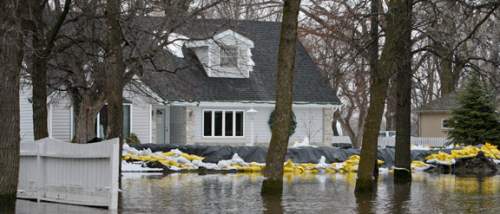
Make sure your home is flood prepared before a natural disaster, including FEMA data, flood maps, flood insurance info and an emergency flood checklist.
While our hearts go out to natural disaster victims across the country, it’s important to keep in mind that floods can happen almost anywhere, and are the most common natural disasters in the U.S. Flooding does not just happen near bodies of water or with rainfall. Take for example a heavy accumulation of snow on a Minnesota farm house. A warm snap happens, and the snow begins to melt while the ground is still frozen. If the house is on flat land, flooding can occur rapidly. A summer flash flood can be just as destructive. In towns, construction and new development take away natural drainage and can increase flooding. In other areas, dam structures can break and rivers can overflow their banks.
According to the National Flood Insurance Program, just three inches of water in a 2,000 square foot home could cost you $22,590 in damages. FEMA reported that the Great Midwestern Flood of 1993 lasted over four months, ruined 49,000 homes and caused at least $16 billion in property damage.
Make a flood plan before there is an emergency
Following are six of the best ways to be prepared before a flood hits:
🌊 Know your flood risk
Keeping in mind the flood scenarios above, think about the flood risk where you are. This is also important to consider before moving or purchasing a home. Check out flood maps for your area on the FEMA website to help assess risk.
☎️ Make a communication plan
Don’t assume your family will be together in an emergency. Decide in advance how to get in touch if cell phone, Internet and landlines don’t work, and how you will let other loved ones know you are safe. Ready.gov has a free communication plan that you can download, fill out and share with family members.
⚕️ Keep an emergency preparedness kit
FEMA has an emergency kit checklist to help you think through what you need to store for your family. It’s also important to refresh stored food and water supplies every six months, and rethink your provisions as your family’s needs change.
🏥 Know where your nearest emergency shelters are located
Your city or township should be able to tell you where to go to get to higher ground, or provide evacuation procedures. Include this information in your communication plan.
📺 Keep informed
If an emergency is imminent, stay tuned to the National Weather Service on the Internet, check your phone, TV, or radio for emergency alerts, weather updates, emergency instructions, or evacuation orders. Keep cell phones on chargers so that you have a full battery when evacuating.
📝 Evaluate purchasing flood insurance
When you consider that in 2015, the average residential flood loss claim was over $43,000, while the average premium was $700, flood insurance may be something to consider. The public service website floodsmart.gov has comprehensive information, including what to ask an agent before purchasing insurance.
We all hope a flood will never happen, but if it does, the best way to survive the tide is with a little advance planning.
Your real estate agent is the best source of information about the local community and real estate topics. Call Tom Verhelst at 218-205-2604 | Karen Zell at 218-731-6836 to learn more about local areas, discuss selling a house, or tour available homes for sale.
